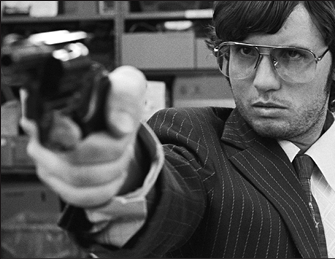By Steven Snyder
The Killing of John Lennon
Written and Directed by Andrew Piddington
IFC Center
323 Sixth Ave. at West 3rd St.
(212-924-7771; ifccenter.com)
The degree to which Andrew Piddington’s “The Killing of John Lennon” will enthrall audiences is proportional to how close those viewers felt to the one-time pop icon; how devastated they were in the days after his cold-blooded assassination at The Dakota in December of 1980.
Or maybe the relationship is inverse-proportional. Not until one of the movie’s final sequences does “John Lennon” reenact the infamous ambush, or hint at the larger ramifications of the singer’s death; the way it was seen by so many Beatles fans as the silencing of one of their generation’s defining voices. In fact, it isn’t until halfway through the film that murderer Mark David Chapman – brought to life here fearlessly by relative newcomer Jonas Ball – even reaches New York City, and almost another 30 minutes before he spots Lennon for the first time.
In some ways, the movie’s title is its greatest liability, ensuring that heartbroken Lennon fans will be denied the story they are expecting to see. “The Killing of John Lennon” is less about Lennon’s killing than about Chapman’s descent into isolation, rage and violence; a two-hour immersion in the desolation of a lost soul who is determined to take others down with him.
It’s a brave and fascinating focus, but nevertheless one that will surely alienate some Beatles buffs who’ll want a little more about the victim and a little less about the attacker — an attacker Piddington all but refuses to judge. Evoking memories of Gus Van Sant’s 2003 masterpiece “Elephant,” which watched passively as two gun-toting children shot up their school, “The Killing of John Lennon” — which premiered at last year’s Tribeca Film Festival — is less a horror story than a psychological case study that probes the mind of the monster.
Glued together with a pervasive Chapman voiceover, scripted from the killer’s detailed diary entries, we initially watch the lonely and confused man struggle with his issues of paranoia and ennui in Hawaii, where we briefly meet his introverted wife and disconnected mother. Plunging deeper and deeper into books, he becomes obsessed with J.D. Salinger’s “The Catcher in the Rye,” re-reading the book obsessively and coming to recite the refrain: “The phony must die says the catcher in the rye!”
Embracing Salinger’s darker themes as his mission statement, Chapman’s next find on the library shelves provides him with a target for his obsessions: A photo album showing Lennon — whose song “Imagine” idealized rejecting material possessions — awash in luxury and wealth. To Chapman, it’s proof of the singer’s hypocrisy and phoniness.
As Chapman flies from Hawaii to New York City (the movie uses almost exclusively real locations), Piddington seems most interested in listing the contradictions that come to define Chapman’s final, destructive days. He has traveled thousands of miles to go on a murderous rampage, yet Chapman finds time to take in a movie (“Ordinary People”), hire a prostitute and do some sightseeing. He has bought a gun and practiced his marksmanship, all because of a seething hatred of Lennon, yet he continuously espouses his love of Lennon’s music, and later expresses his excitement over getting Lennon’s autograph. When he commits himself to using his trial as a platform to promote Salinger’s book, it becomes impossible to take Chapman, or his supposed motivations, seriously.
Is Chapman purely deranged? Meticulously calculated? A superficial fame-seeker, or a monster adhering to some set of morbid ideals? The further Chapman falls off the perch of sanity, swinging between emotional states and reasons for his stalking, the more Piddington distorts the aesthetic of the film, stretching its focus, its colors and borders to create something of a kaleidoscope of insanity. Chapman’s world literally looks like a supernatural landscape foreign to our eyes and minds, and we come to realize there is no secret key to unlocking the mysteries of his madness. Lennon isn’t the focus of the movie, because he’s not even really the focus of Chapman’s hatred. He’s just the celebrity who happened to wander into this madman’s crosshairs — the wrong library book, at the wrong time.






























